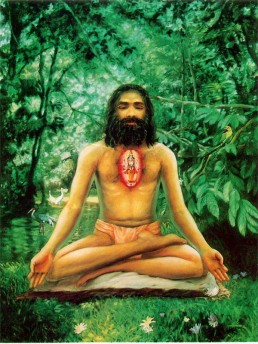Swami Chinmayananda Commentary
Krishna is repeating the same idea, lest Arjuna should overlook the fact that what they call Samnyasa, the “renunciation of agency,” is itself Yoga, the “renunciation of the fruits-of-action.” Samnyasa is the state reached through Yoga, the practice; and the spiritual practice of Yoga cannot even be thought of without the spirit of Samnyasa in the bosom. The two are the obverse and the reverse of the same coin of spiritual perfection!
It is but natural that the intellectually independent thinker in Arjuna should, at this juncture, ask the question “Why?” with raised brows, seeing which, the Charioteer implicitly gives the logical reasons behind his seemingly outrageous and daring conclusion. The Lord explains that, never can one become established in the practices for one’s own cultural-rehabilitation unless one has learnt the art of renouncing all Sankalpas.
Man cannot ordinarily remain without imagining and constantly creating, in his exuberant fancy. And in his imagination he invariably tries to pull down the beautiful veil thrown over the face of the future. Ripping open this veil over the unknown, everyone of us, on all occasions, in our imaginations, fix for ourselves a goal to be fulfilled by us in the near future. Having fixed up the temporary goal, our mind plans and creates a method of achieving that hazy goal. But ere we execute our plans and enter into the field of effort to carve out a success for ourselves, the never-tiring, ever-active power of imagination in us would already have wiped clean the goal fixed earlier, and have rewritten a modified destination to be gained in the future.
By the time we prepare ourselves mentally and start executing our ideas in life, our mischievous fancy would again have wiped the distant goal clean. Thus each time the goal remains only so long as we have not started our pilgrimage to it; and the moment we start the pilgrimage, the goal fades away from our vision!
In short, when we have got a goal we have not yet started acting, and the moment we start the strife, we seem to have no goal to reach. The subtle force in our inner composition which unconsciously creates this lunatic temperament in us is called the unbridled Sankalpa Shakti.
We need no help from any great commentators to understand that no achievement, either without or within us, can be gained so long as we have not pursued, arrested, and finally destroyed this dangerous inner saboteur called ‘Sankalpa.’
To show that there is no compromise in this, Bhagawan is using a very positive term that none (kashchana) can ever reach any progress on the path of self-redemption without acquiring a capacity to renounce this self-poisoning Sankalpa-disturbance.
KARMA YOGA, PRACTISED WITHOUT REGARD TO THE FRUIT OF ACTION FORMS AN EXTERNAL AID (BAHIRANGA SADHANA) TO DHYANA YOGA. THE LORD NOW PROCEEDS TO SHOW HOW KARMA YOGA IS A MEANS TO BETTER AND GREATER MEDITATION.
Adi Sankara Commentary
Yam, that which is characterized by the giving up of all actions and their results; which prahuh, they, the knowers of the Vedas and the Smrtis, call; sannyasam iti, monasticism, in the real sense; viddhi, known; tam, that monasticism in the real sense; to be yogam, Yoga, consisting in the performance of actions, O Pandava. Accepting what kind of similarity between Karma-yoga, which is characterized by engagement (in actions), and its opposite, renunciation in the real sense, which is characterized by cessation from work, has their equation been stated? When such an apprehension arises, the answer is this; From the point of view of the agent, there does exist a simialrity of Karma-yoga with real renunciation. For he who is a monk in the real sense, from the very fact of his having given up all the means needed for accomplishing actions, gives up the thought of all actions and their results-the source of desire that leads to engagement in work. [Thoughts about an object lead to the desire for it, which in turn leads to actions for getting it. (Also see note under 4.19)] also, even while performing actions, gives up the thought for results. Pointing out this idea, the Lord says: Hi, for; kascit, nobody, no man of action whosoever; asannyasta-sankalpah, who has not given up expactaions-one by whom has not been renounced expectation, anticipation, of results;bhavati, becomes, i.e. can become; yogi, a yogi, a man of concentration, because thought of results is the cause of the disturbance of mind. Therefore, any man of action who gives up the thought of results would become a yogi, a man of concentration with an unperturbed mind, because of his having given up thought of results which is the cause of mental distractions. This is the purport. Thus, because of the similarity of real monasticism with Karma-yoga from the point of veiw of giving up by the agent, Karma-yoga is extolled as monasticism in, ‘That which they call monasticism, know that to be Yoga, O Pandava.’ Since Karma-yoga, which is independent of results, is the remote help to Dhyana-yoga, therefore it has been praised as monasticism. Thereafter, now the Lord shows how Karma-yoga is helpful to Dhyana-yoga:
The Bhagavad Gita with the commentary of Sri Sankaracharya – Translated by Alladi Mahadeva Sastry
Holy Geeta – Commentary by Swami Chinmayananda
The Bhagavad Gita by Eknath Easwaran – Best selling translation of the Bhagavad Gita
The Bhagavad Gita – Translation and Commentary by Swami Sivananda
Bhagavad Gita – Translation and Commentary by Bhaktivedanta Swami Prabupadha
Srimad Bhagavad Gita Chapter 6 – Verse 2 – 6.2 yam samnyasamiti – All Bhagavad Gita (Geeta) Verses in Sanskrit, English, Transliteration, Word Meaning, Translation, Audio, Shankara Bhashya, Adi Sankaracharya Commentary and Links to Videos by Swami Chinmayananda and others – 6-2

